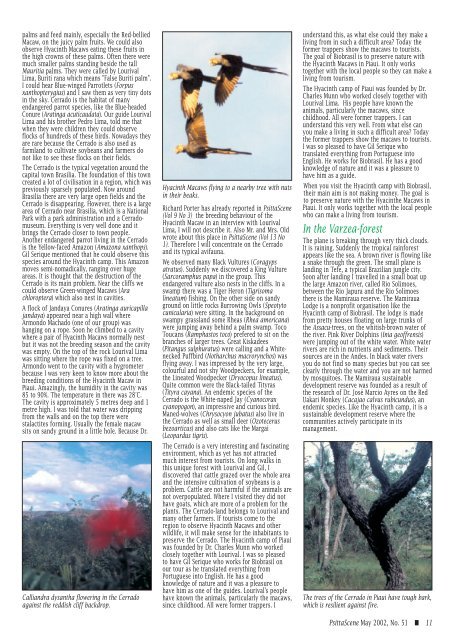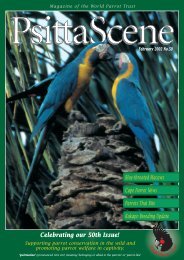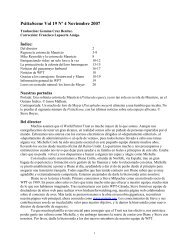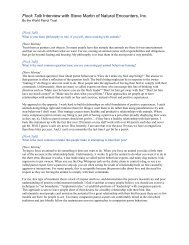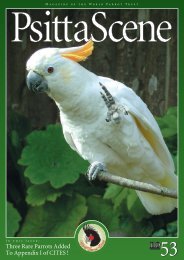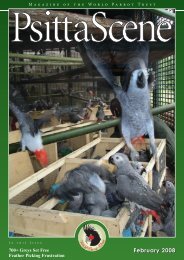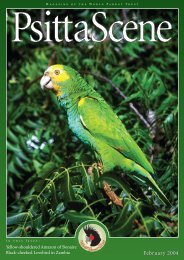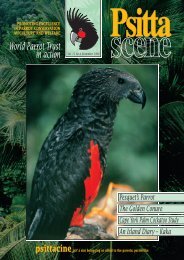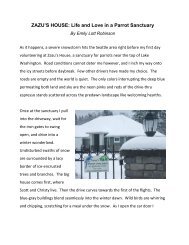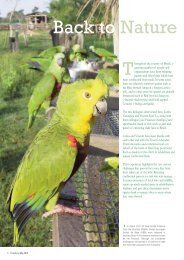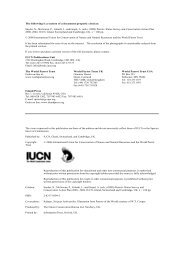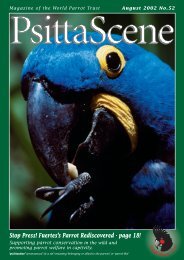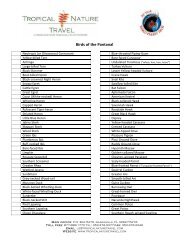Parrots in the Wild - World Parrot Trust
Parrots in the Wild - World Parrot Trust
Parrots in the Wild - World Parrot Trust
Create successful ePaper yourself
Turn your PDF publications into a flip-book with our unique Google optimized e-Paper software.
palms and feed ma<strong>in</strong>ly, especially <strong>the</strong> Red-bellied<br />
Macaw, on <strong>the</strong> juicy palm fruits. We could also<br />
observe Hyac<strong>in</strong>th Macaws eat<strong>in</strong>g <strong>the</strong>se fruits <strong>in</strong><br />
<strong>the</strong> high crowns of <strong>the</strong>se palms. Often <strong>the</strong>re were<br />
much smaller palms stand<strong>in</strong>g beside <strong>the</strong> tall<br />
Mauritia palms. They were called by Lourival<br />
Lima, Buriti rana which means "False Buriti palm".<br />
I could hear Blue-w<strong>in</strong>ged <strong>Parrot</strong>lets (Forpus<br />
xanthopterygius) and I saw <strong>the</strong>m as very t<strong>in</strong>y dots<br />
<strong>in</strong> <strong>the</strong> sky. Cerrado is <strong>the</strong> habitat of many<br />
endangered parrot species, like <strong>the</strong> Blue-headed<br />
Conure (Arat<strong>in</strong>ga acuticaudata). Our guide Lourival<br />
Lima and his bro<strong>the</strong>r Pedro Lima, told me that<br />
when <strong>the</strong>y were children <strong>the</strong>y could observe<br />
flocks of hundreds of <strong>the</strong>se birds. Nowadays <strong>the</strong>y<br />
are rare because <strong>the</strong> Cerrado is also used as<br />
farmland to cultivate soybeans and farmers do<br />
not like to see <strong>the</strong>se flocks on <strong>the</strong>ir fields.<br />
The Cerrado is <strong>the</strong> typical vegetation around <strong>the</strong><br />
capital town Brasilia. The foundation of this town<br />
created a lot of civilisation <strong>in</strong> a region, which was<br />
previously sparsely populated. Now around<br />
Brasilia <strong>the</strong>re are very large open fields and <strong>the</strong><br />
Cerrado is disappear<strong>in</strong>g. However, <strong>the</strong>re is a large<br />
area of Cerrado near Brasilia, which is a National<br />
Park with a park adm<strong>in</strong>istration and a Cerradomuseum.<br />
Everyth<strong>in</strong>g is very well done and it<br />
br<strong>in</strong>gs <strong>the</strong> Cerrado closer to town people.<br />
Ano<strong>the</strong>r endangered parrot liv<strong>in</strong>g <strong>in</strong> <strong>the</strong> Cerrado<br />
is <strong>the</strong> Yellow-faced Amazon (Amazona xanthops).<br />
Gil Serique mentioned that he could observe this<br />
species around <strong>the</strong> Hyac<strong>in</strong>th camp. This Amazon<br />
moves semi-nomadically, rang<strong>in</strong>g over huge<br />
areas. It is thought that <strong>the</strong> destruction of <strong>the</strong><br />
Cerrado is its ma<strong>in</strong> problem. Near <strong>the</strong> cliffs we<br />
could observe Green-w<strong>in</strong>ged Macaws (Ara<br />
chloroptera) which also nest <strong>in</strong> cavities.<br />
A flock of Jandaya Conures (Arat<strong>in</strong>ga auricapilla<br />
jandaya) appeared near a high wall where<br />
Armondo Machado (one of our group) was<br />
hang<strong>in</strong>g on a rope. Soon he climbed to a cavity<br />
where a pair of Hyac<strong>in</strong>th Macaws normally nest<br />
but it was not <strong>the</strong> breed<strong>in</strong>g season and <strong>the</strong> cavity<br />
was empty. On <strong>the</strong> top of <strong>the</strong> rock Lourival Lima<br />
was sitt<strong>in</strong>g where <strong>the</strong> rope was fixed on a tree.<br />
Armondo went to <strong>the</strong> cavity with a hygrometer<br />
because I was very keen to know more about <strong>the</strong><br />
breed<strong>in</strong>g conditions of <strong>the</strong> Hyac<strong>in</strong>th Macaw <strong>in</strong><br />
Piaui. Amaz<strong>in</strong>gly, <strong>the</strong> humidity <strong>in</strong> <strong>the</strong> cavity was<br />
85 to 90%. The temperature <strong>in</strong> <strong>the</strong>re was 28°C.<br />
The cavity is approximately 5 metres deep and 1<br />
metre high. I was told that water was dripp<strong>in</strong>g<br />
from <strong>the</strong> walls and on <strong>the</strong> top <strong>the</strong>re were<br />
stalactites form<strong>in</strong>g. Usually <strong>the</strong> female macaw<br />
sits on sandy ground <strong>in</strong> a little hole. Because Dr.<br />
Calliandra dysantha flower<strong>in</strong>g <strong>in</strong> <strong>the</strong> Cerrado<br />
aga<strong>in</strong>st <strong>the</strong> reddish cliff backdrop.<br />
Hyac<strong>in</strong>th Macaws fly<strong>in</strong>g to a nearby tree with nuts<br />
<strong>in</strong> <strong>the</strong>ir beaks.<br />
Richard Porter has already reported <strong>in</strong> PsittaScene<br />
(Vol 9 No 3) <strong>the</strong> breed<strong>in</strong>g behaviour of <strong>the</strong><br />
Hyac<strong>in</strong>th Macaw <strong>in</strong> an <strong>in</strong>terview with Lourival<br />
Lima, I will not describe it. Also Mr. and Mrs. Old<br />
wrote about this place <strong>in</strong> PsittaScene (Vol 13 No<br />
1). Therefore I will concentrate on <strong>the</strong> Cerrado<br />
and its typical avifauna.<br />
We observed many Black Vultures (Coragyps<br />
atratus). Suddenly we discovered a K<strong>in</strong>g Vulture<br />
(Sarcoramphus papa) <strong>in</strong> <strong>the</strong> group. This<br />
endangered vulture also nests <strong>in</strong> <strong>the</strong> cliffs. In a<br />
swamp <strong>the</strong>re was a Tiger Heron (Tigrisoma<br />
l<strong>in</strong>eatum) fish<strong>in</strong>g. On <strong>the</strong> o<strong>the</strong>r side on sandy<br />
ground on little rocks Burrow<strong>in</strong>g Owls (Speotyto<br />
cunicularia) were sitt<strong>in</strong>g. In <strong>the</strong> background on<br />
swampy grassland some Rheas (Rhea americana)<br />
were jump<strong>in</strong>g away beh<strong>in</strong>d a palm swamp. Toco<br />
Toucans (Ramphastos toco) prefered to sit on <strong>the</strong><br />
branches of larger trees. Great Kiskadees<br />
(Pitangus sulphuratus) were call<strong>in</strong>g and a Whitenecked<br />
Puffbird (Notharchus macrorynchos) was<br />
fly<strong>in</strong>g away. I was impressed by <strong>the</strong> very large,<br />
colourful and not shy Woodpeckers, for example,<br />
<strong>the</strong> L<strong>in</strong>eated Woodpecker (Dryocopus l<strong>in</strong>eatus).<br />
Quite common were <strong>the</strong> Black-tailed Tityras<br />
(Tityra cayana). An endemic species of <strong>the</strong><br />
Cerrado is <strong>the</strong> White-naped Jay (Cyanocorax<br />
cyanopogon), an impressive and curious bird.<br />
Maned-wolves (Chrysocyon jubatus) also live <strong>in</strong><br />
<strong>the</strong> Cerrado as well as small deer (Ozotecerus<br />
bezoarticus) and also cats like <strong>the</strong> Margai<br />
(Leopardus tigris).<br />
The Cerrado is a very <strong>in</strong>terest<strong>in</strong>g and fasc<strong>in</strong>at<strong>in</strong>g<br />
environment, which as yet has not attracted<br />
much <strong>in</strong>terest from tourists. On long walks <strong>in</strong><br />
this unique forest with Lourival and Gil, I<br />
discovered that cattle grazed over <strong>the</strong> whole area<br />
and <strong>the</strong> <strong>in</strong>tensive cultivation of soybeans is a<br />
problem. Cattle are not harmful if <strong>the</strong> animals are<br />
not overpopulated. Where I visited <strong>the</strong>y did not<br />
have goats, which are more of a problem for <strong>the</strong><br />
plants. The Cerrado-land belongs to Lourival and<br />
many o<strong>the</strong>r farmers. If tourists come to <strong>the</strong><br />
region to observe Hyac<strong>in</strong>th Macaws and o<strong>the</strong>r<br />
wildlife, it will make sense for <strong>the</strong> <strong>in</strong>habitants to<br />
preserve <strong>the</strong> Cerrado. The Hyac<strong>in</strong>th camp of Piaui<br />
was founded by Dr. Charles Munn who worked<br />
closely toge<strong>the</strong>r with Lourival. I was so pleased<br />
to have Gil Serique who works for Biobrasil on<br />
our tour as he translated everyth<strong>in</strong>g from<br />
Portuguese <strong>in</strong>to English. He has a good<br />
knowledge of nature and it was a pleasure to<br />
have him as one of <strong>the</strong> guides. Lourival’s people<br />
have known <strong>the</strong> animals, particularly <strong>the</strong> macaws,<br />
s<strong>in</strong>ce childhood. All were former trappers. I<br />
understand this, as what else could <strong>the</strong>y make a<br />
liv<strong>in</strong>g from <strong>in</strong> such a difficult area? Today <strong>the</strong><br />
former trappers show <strong>the</strong> macaws to tourists.<br />
The goal of Biobrasil is to preserve nature with<br />
<strong>the</strong> Hyac<strong>in</strong>th Macaws <strong>in</strong> Piaui. It only works<br />
toge<strong>the</strong>r with <strong>the</strong> local people so <strong>the</strong>y can make a<br />
liv<strong>in</strong>g from tourism.<br />
The Hyac<strong>in</strong>th camp of Piaui was founded by Dr.<br />
Charles Munn who worked closely toge<strong>the</strong>r with<br />
Lourival Lima. His people have known <strong>the</strong><br />
animals, particularly <strong>the</strong> macaws, s<strong>in</strong>ce<br />
childhood. All were former trappers. I can<br />
understand this very well. From what else can<br />
you make a liv<strong>in</strong>g <strong>in</strong> such a difficult area? Today<br />
<strong>the</strong> former trappers show <strong>the</strong> macaws to tourists.<br />
I was so pleased to have Gil Serique who<br />
translated everyth<strong>in</strong>g from Portuguese <strong>in</strong>to<br />
English. He works for Biobrasil. He has a good<br />
knowledge of nature and it was a pleasure to<br />
have him as a guide.<br />
When you visit <strong>the</strong> Hyac<strong>in</strong>th camp with Biobrasil,<br />
<strong>the</strong>ir ma<strong>in</strong> aim is not mak<strong>in</strong>g money. The goal is<br />
to preserve nature with <strong>the</strong> Hyac<strong>in</strong><strong>the</strong> Macaws <strong>in</strong><br />
Piaui. It only works toge<strong>the</strong>r with <strong>the</strong> local people<br />
who can make a liv<strong>in</strong>g from tourism.<br />
In <strong>the</strong> Varzea-forest<br />
The plane is break<strong>in</strong>g through very thick clouds.<br />
It is ra<strong>in</strong><strong>in</strong>g. Suddenly <strong>the</strong> tropical ra<strong>in</strong>forest<br />
appears like <strong>the</strong> sea. A brown river is flow<strong>in</strong>g like<br />
a snake through <strong>the</strong> green. The small plane is<br />
land<strong>in</strong>g <strong>in</strong> Tefe, a typical Brazilian jungle city.<br />
Soon after land<strong>in</strong>g I travelled <strong>in</strong> a small boat up<br />
<strong>the</strong> large Amazon river, called Rio Solimoes,<br />
between <strong>the</strong> Rio Japura and <strong>the</strong> Rio Solimoes<br />
<strong>the</strong>re is <strong>the</strong> Mamiraua reserve. The Mamiraua<br />
Lodge is a nonprofit organisation like <strong>the</strong><br />
Hyac<strong>in</strong>th camp of Biobrasil. The lodge is made<br />
from pretty houses float<strong>in</strong>g on large trunks of<br />
<strong>the</strong> Assacu-trees, on <strong>the</strong> whitish-brown water of<br />
<strong>the</strong> river. P<strong>in</strong>k River Dolph<strong>in</strong>s (Inia geoffrensis)<br />
were jump<strong>in</strong>g out of <strong>the</strong> white water. White water<br />
rivers are rich <strong>in</strong> nutrients and sediments. Their<br />
sources are <strong>in</strong> <strong>the</strong> Andes. In black water rivers<br />
you do not f<strong>in</strong>d so many species but you can see<br />
clearly through <strong>the</strong> water and you are not harmed<br />
by mosquitoes. The Mamiraua susta<strong>in</strong>able<br />
development reserve was founded as a result of<br />
<strong>the</strong> research of Dr. José Marcio Ayres on <strong>the</strong> Red<br />
Uakari Monkey (Cacajao calvus rubicundus), an<br />
endemic species. Like <strong>the</strong> Hyac<strong>in</strong>th camp, it is a<br />
susta<strong>in</strong>able development reserve where <strong>the</strong><br />
communities actively participate <strong>in</strong> its<br />
management.<br />
The trees of <strong>the</strong> Cerrado <strong>in</strong> Piaui have tough bark,<br />
which is resilient aga<strong>in</strong>st fire.<br />
PsittaScene May 2002, No. 51 ■ 11


